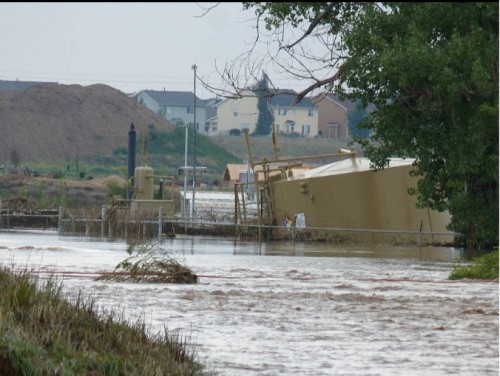FRACKING HELL -- A MASSIVE ENVIRONMENTAL DISASTER IS UNFOLDING IN COLORADO AND THE MEDIA IS SILENT!
THOUSANDS of gas wells across Colorado are underwater. Huge storage tanks of carcinogenic and neurotoxic chemicals are being displaced and overturned by the massive floodwaters. These toxins will end up polluting the soil, air and groundwater for decades at least!
Photo taken by a resident of Weld County, Colorado:
This is exactly happens when you frack in a flood plain! Obviously greed came into play over safety issues when permits were issued.
From the Denver Post:
“Oil drums, tanks and other industrial debris mixed into the swollen river flowing northeast. County officials did not give locations of where the pipeline broke and where other pipelines were compromised.
While the water levels in the South Platte appear to be receding slightly, bridges over the South Platte have been closed as water overflowed the bridges at least as far east as Morgan County.
Oil and gas industry crews have been monitoring wells drilled into the flood plain east of Greeley in Weld County.
One pipeline has broken and is leaking, Weld County Emergency Manager Roy Rudisill. Other industry pipelines are sagging as saturated sediment erodes around the expanding river.
Industry crews “are shutting in the lines, shutting in the wells,” Rudisill said.
In a statement, Gary Wockner, of Clean Water Action, said “Fracking and operating oil and gas facilities in floodplains is extremely risky. Flood waters can topple facilities and spread oil, gas, and cancer-causing fracking chemicals across vast landscapes making contamination and clean-up efforts exponentially worse and more complicated.”
Gas line rupture east of Greeley:
From The Daily Camera:
"Inundated along with roads, bridges, houses and farms are thousands of oil and gas wells and associated condensate tanks and ponds in northeast Boulder County and southwest Weld County.
Anti-fracking activists say the industry needs to account for what types of chemicals may be contaminating soil and groundwater in the area around these wells.
The concentration of oil and gas wells in flood-prone areas speaks to one more risk of what they see as a dangerous industry.
Regulators say they agree these well sites could pose a contamination risk, and they will get out to assess the damage as soon as it's feasible.
An Encana Oil and Gas representative said many wells were "shut in" in anticipation of the flood to minimize the risk.
Lafayette-based anti-fracking activist Cliff Willmeng said he spent two days "zig-zagging" across Weld and Boulder counties documenting flooded drilling sites, mostly along the drainageway of the St. Vrain River. He observed "hundreds" of wells that were inundated. He also saw many condensate tanks that hold waste material from fracking at odd angles or even overturned.
"It's clear that the density of the oil and gas activity there did not respect where the water would go," Willmeng said. "What we immediately need to know is what is leaking and we need a full detailed report of what that is. This is washing across agricultural land and into the waterways. Now we have to discuss what type of exposure the human population is going to have to suffer through."
Colorado Oil and Gas Association President Tisha Schuller said in an email that the industry prepares and drills for these types of natural disasters and opened 24-hour incident command centers to monitor wells and mitigate potential hazards.
"We are working around the clock to monitor, prevent, and address the effects of flooding," she said. "In cases where personnel could be freed up, they have been made available to communities for flood rescue and relief efforts."
A spokesman for the Colorado Oil and Gas Conservation Commission said the agency is aware of the potential for contamination from flooded drilling sites, but there simply is no way to get to those sites while flooding is ongoing and while resources are concentrated on saving lives.
"COGCC will be working with state and local authorities to assess risks and, where necessary, provide environmental response and remediation," said Todd Hartman, a spokesman for the Department of Natural Resources.
Hartman said many operators have added security to tanks, like chains to make sure they don't float away, though aerial photographs have shown floating and drifting tanks in some flooded areas.
Also, many operators "shut in" or closed down well operations in anticipation of flooding.
Wendy Wiedenbeck, a spokeswoman for Encana, a major gas driller in the region, said in a news release that the company shut-in production at wells throughout the affected areas and has remote monitoring to stop production at additional wells if they are affected by flooding.
Crews are conducting site-by-site visits as it becomes safe to do so, she said.
Willmeng said shutting-in does not isolate all the hydrocarbons in case of flooding. He's also concerned that there simply aren't enough inspectors to deal with all the wells.
Andrew Barth, a city spokesman working with the Boulder Office of Emergency Management during the disaster, said local officials are well aware of potential problems from drilling wells, as well as from flooded gas stations and industrial sites. However, inspections and assessment will have to wait until the immediate threat to life and safety has passed.
"We've seen those same pictures, and we are concerned," he said. "We are going to go out and look at those as once we're out of the immediate search and rescue phase."
More Photos in this article:
http://intellihub.com/2013/09/16/colorado-flood-creates-fracking-chemical-spill-report/

